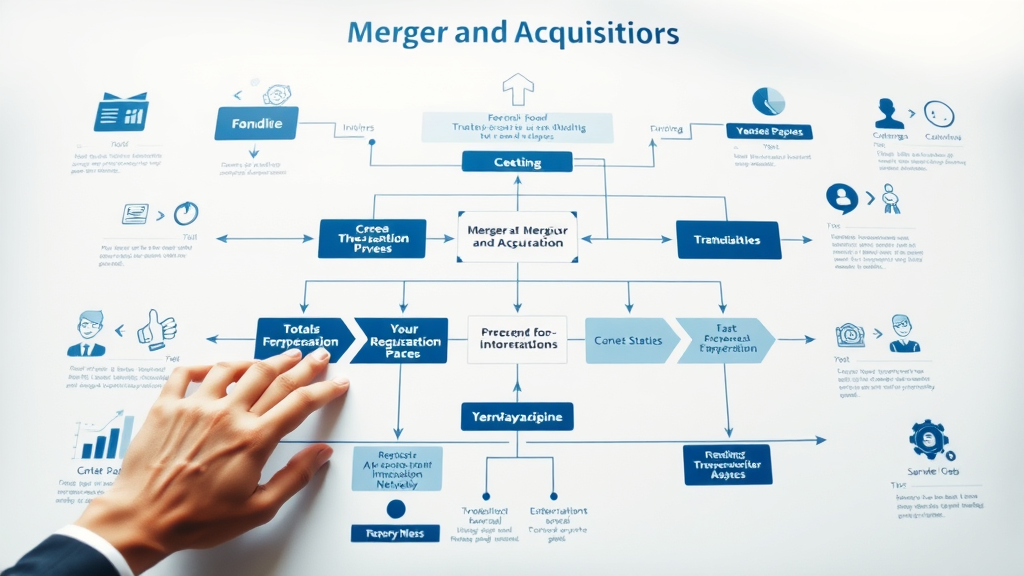Did you know that nearly 70% of Fortune 500 companies owe their enormous wealth to strategic mergers and acquisitions ? While most investors build portfolios slowly, there’s a powerful, less-talked-about path: orchestrating or investing in mergers and acquisitions (M&A). Unlocking the secrets of M&A could be your ticket to remarkable financial growth. In this guide, you’ll find highly practical insights and real-world examples to show you how merger-driven strategies fuel wealth —and how you can harness them to take your finances to the next level.
Discover How Mergers and Acquisitions Drive Wealth Building—An Unexpected Truth Revealed
Mergers and acquisitions are more than just headlines in the business news; they’re a hidden force transforming companies and accelerating wealth. Whether it’s a behemoth tech merger or a regional asset purchase, each deal is a strategic move aimed at scaling market share, optimizing cash flow, and opening new revenue streams. For investors and business owners alike, understanding how and why these transactions happen is pivotal to building—and protecting—substantial wealth.
Take Disney's acquisition of Marvel or Google's string of tech purchases—these moves expanded not just their customer base, but also technology, intellectual property, and global reach. What’s often missed is the behind-the-scenes strategy: an acquiring firm targeting a target company for its potential to turbocharge revenue, realize efficiencies, or even eliminate competitors. The truth is, successful mergers and acquisitions deliver compounding returns and opportunities that traditional investment avenues simply can’t match.

What makes mergers and acquisitions a hidden engine of financial growth?
The secret potency of mergers and acquisitions lies in their ability to fuse resources, knowledge, and customer bases —often instantly scaling market share and profitability. By combining their operations, the acquiring company and the target firm can achieve immediate increases in efficiency (think supply chain synergies or reduced overhead), while unlocking new distribution channels and intellectual property. In many markets, M&A is seen as the fastest route to significant cash flow improvements and capital gains, enabling both business operations and investors to thrive.
Furthermore, M&A is not just for industry giants. Mid-sized enterprises, family businesses, and even individuals can reap rewards by understanding how to position themselves in the deal-making ecosystem. With globalization and technology lowering barriers, opportunities abound at every scale. The key? Mastering the nuances of due diligence , post-merger integration, and deal structure—skills that directly impact the bottom line.
For those interested in how regulatory decisions can influence the outcome of major deals, the recent Chevron Hess merger and the role of public input on FTC decisions offer a timely example of how board control and compliance can shape the future of mergers and acquisitions.
"Nearly 70% of Fortune 500 companies owe their exponential wealth to strategic mergers and acquisitions."
What You Will Gain From Mastering Mergers and Acquisitions
- In-depth understanding of mergers and acquisitions fundamentals
- Strategies for leveraging private equity
- Essential roles of investment banks
- Real-world examples of wealth creation through M&A
- How to identify and evaluate tender offers
- Critical insights on maximizing deal cash flow
Understanding Mergers and Acquisitions: The Foundation of Wealth Growth
Mergers and acquisitions defined: What every investor must know
Mergers and acquisitions (M&A) refer to the financial transactions through which companies consolidate, either by joining as equals (merger) or by one company purchasing another (acquisition). In a merger , two firms combine to form one new entity—often to enhance efficiencies, gain greater market share , or strengthen their position in the supply chain. In an acquisition , the acquiring firm takes control of a target firm, integrating its assets and operations. Both methods are vital for companies aiming to accelerate growth, diversify their customer base, and optimize cash flow.
For investors, understanding the mechanics of M&A uncovers opportunities to assess risk and identify potentially lucrative bets. Each transaction—friendly or hostile—must be approached with exhaustive due diligence, including valuation methods, analysis of assets and liabilities , and compliance with governing bodies like the Securities and Exchange Commission (SEC) in the United States. The rewards for those who master these essentials? A true edge in wealth-building prospects, whether as a shareholder, a participant, or an advisor.

The difference between mergers and acquisitions—why both matter
Though related, mergers and acquisitions differ in structure and intent. A merger is essentially a partnership of equals—think of two mid-sized firms in the same industry combining to outpace the competition. For example, when Exxon and Mobil merged, they instantly became an energy giant, leveraging both of their market shares for global advantage. Conversely, an acquisition is when one company (the acquiring company) completely purchases and takes over another (the target company), as with Amazon’s acquisition of Whole Foods. This often leads to a shift in control and can be executed via asset purchase, tender offer, or stock swap.
This distinction matters because the chosen route affects everything from ownership structure and tax considerations to how synergies are realized. For investors and executives, recognizing which approach suits a specific scenario is essential—not just to maximize wealth, but also to ensure seamless integration and post-transaction cash flow. Whether the deal is friendly or hostile, the endgame is value creation for shareholders of the acquiring company and often for the target company, too.
| Type | Description | Example | Impact on Wealth |
|---|---|---|---|
| Merger | Two companies of similar size combine to form a new entity. | Exxon + Mobil | Market expansion, greater efficiency, shareholder value grows |
| Acquisition | One company fully absorbs another, becoming its owner. | Amazon buys Whole Foods | Instant access to customer base, supply chain enhancements, cash flow boost |
The Role of Private Equity in Mergers and Acquisitions
How private equity firms influence global mergers and acquisitions
Private equity firms are the behind-the-scenes architects of many significant mergers and acquisitions. These entities pool capital from institutions and high-net-worth individuals to buy, restructure, and grow companies before either selling them or taking them public. By actively seeking opportunities to acquire firms—usually those with solid fundamentals but untapped potential—private equity firms fuel innovation and business expansion at an unprecedented scale.
Globally, private equity has reshaped entire industries, from healthcare to technology, using its reach and expertise to identify companies poised for exponential growth. Their influence is particularly powerful in the middle market, where their partnership brings not only capital but also operational know-how, strategic planning, and access to a broader customer base. The result? Both the acquiring company and target company experience transformed business operations, elevated valuations, and in many cases, generational wealth creation.

Private equity strategies that accelerate wealth creation
At the heart of private equity’s success in mergers and acquisitions is a collection of well-honed strategies: leveraged buyouts, recapitalizations, and platform-building. With a strong focus on maximizing cash flow, private equity firms often employ rigorous due diligence to ensure that the purchase price aligns with future value creation prospects. They then implement operational improvements, streamline the supply chain, and encourage expansion into new markets—delivering above-market returns both for investors and the companies involved.
Private equity also often utilizes roll-up strategies—acquiring multiple small companies in fragmented industries and combining them to form scalable operations, increasing both market share and valuations ahead of a lucrative exit. These methods, when paired with creative financing, partnership with investment banks, or even the use of a shell company for a reverse merger, make private equity indispensable for those aiming to maximize wealth through M&A.
"Private equity is the secret sauce behind many of the world's largest and most successful corporate mergers and acquisitions."
Investment Banks: Facilitators of Successful Mergers and Acquisitions
Why investment banks are essential in mergers and acquisitions
Investment banks are the expert navigators guiding companies through the complex waters of mergers and acquisitions . They provide critical advisory services—assessing valuation methods, structuring deals, arranging financing, and ensuring every aspect aligns with regulatory requirements. Their role doesn’t end at negotiation; they’re involved in due diligence, identifying synergies, and managing relationships between the buyer and seller to drive successful outcomes.
For both acquirers and target companies, investment banks offer not just technical expertise but also access to capital markets, a rolodex of buyers and investors, and insight into competitive landscapes. When selecting an investment bank, factors such as industry specialization, past M&A experience, and global reach should be closely weighed. The right partnership can mean the difference between a seamless transaction and costly missteps, making these institutions central to any savvy M&A strategy.

How to choose the right investment bank for your M&A goals
Selecting the best investment bank for your mergers and acquisitions journey hinges on alignment with your industry, transaction size, and desired outcomes. Look for banks with deep experience in your sector—they’ll understand your unique business operations and have insight into market trends that affect your valuation. Equally important is their access to a robust network of potential buyers and sellers, ensuring you’re well-matched in any negotiation.
Request case studies or references, ask about their due diligence protocols, and understand their pricing structure. A top-tier investment bank won’t just help you close a deal—they’ll enhance every stage of the process, from crafting creative deal structures to monitoring integration and ensuring that post-acquisition cash flow targets are not just met but exceeded.
| Service | Description | Importance in M&A |
|---|---|---|
| Advisory | Provide strategic recommendations for deal structure, timing, and negotiation. | Ensures deals maximize synergies and value for acquirer and target firm. |
| Due Diligence | Examine assets, liabilities, legal exposures, and operational risks. | Mitigates risk, uncovers hidden opportunities, and determines fair price. |
| Negotiation | Lead discussions and arguments for the best possible terms. | Protects client interests and ensures favorable purchase price or sale. |
| Financing | Arranges funding sources, including loans, equity, or bond issuance. | Enables even large-scale M&A that might be otherwise out of reach. |
Types of Mergers and Acquisitions: Structures and Their Wealth Impacts
Horizontal, vertical, conglomerate, and market-extension mergers explained
Successful mergers and acquisitions aren’t one-size-fits-all—they’re shaped by industry, company goals, and the wealth impact for all parties involved. Horizontal mergers bring together firms in the same industry, allowing them to expand their market share or achieve economies of scale, such as the historic Disney-Pixar deal. Vertical mergers unite companies across different stages of the supply chain, driving efficiencies—think Apple’s acquisition of component manufacturers to control production quality and cost.
Then there are conglomerate mergers , where unrelated businesses combine, reducing risk and diversifying income streams. Market-extension mergers unite companies with similar products but different marketing territories, instantly leveraging both customer base and revenue potential. Each structure offers distinct strategies for value enhancement, and understanding their mechanics is crucial for making informed M&A decisions that have direct, positive impacts on your wealth.

Strategic impacts on your wealth: which type of merger or acquisition yields the highest return?
When it comes to maximizing wealth through mergers and acquisitions , the type of deal you pursue can make a world of difference. Horizontal mergers generally offer the quickest path to increased market share and cost savings, resulting in substantial boosts to cash flow and profitability. Vertical mergers, on the other hand, provide lasting control over the supply chain, which can reduce costs and improve margins in the long run.
Conglomerate and market-extension mergers can be lucrative for investors seeking diversification and access to untapped markets. The most successful deals are those that are rigorously analyzed by the acquiring company and investment banks, ensuring not only immediate synergies but also sustainable value kickers for the future. Regardless of the path you choose, remember: detailed due diligence and strong post-merger integration are non-negotiable for maximizing ROI and securing generational wealth.
Tender Offers: Unlocking Opportunities in Mergers and Acquisitions
How tender offers shape the mergers and acquisitions landscape
A tender offer is a unique M&A tool where an acquiring company publicly proposes to purchase shares directly from the shareholders of a target firm, typically at a premium to the current market price. This mechanism accelerates deal timelines, often bypassing the board of directors of the target company if a traditional friendly negotiation stalls. Tender offers can be used in both friendly or hostile scenarios and are closely scrutinized by the Securities and Exchange Commission, especially in the United States.
Tender offers are most common in situations where the acquiring company wants to gain control of a publicly listed company quickly, such as in the famous Kraft Foods-Cadbury takeover. For investors, monitoring tender offers can unveil time-sensitive opportunities to capitalize on price premiums—but caution is warranted as these deals come with heightened risk and regulatory complexity.
Investor tips: Evaluating and capitalizing on tender offers
To successfully profit from a tender offer , investors must practice diligent research and remain alert to both opportunities and red flags. Careful analysis of the buyer’s strategic intent, the purchase price relative to market value, and the financial health of both parties is fundamental. Keep an eye out for terms that seem too generous or laden with exit clauses, as these can indicate underlying issues.
Participating in a tender offer isn’t simply about accepting a premium price—it’s about vetting the acquiring firm’s track record, understanding the implications for cash flow post-deal, and evaluating the longer-term strategy. Engaging with your financial advisor and studying past case studies—both successful and failed—will help you avoid common missteps and make the most of lucrative M&A windows.
- Key steps in a tender offer process
- Red flags to watch for in tender offers
- Case studies: Successful and failed tender offers
Cash Flow Mastery: Maximizing Value from Mergers and Acquisitions
Why cash flow analysis is critical during mergers and acquisitions
Regardless of how promising a merger or acquisition may seem on paper, it’s the impact on cash flow that ultimately determines its true value. During due diligence, both acquiring and target companies meticulously analyze current cash generation capabilities, forecast potential synergies, and stress-test various growth scenarios. For investors, understanding these projections helps predict whether future returns will meet expectations—and whether the purchase price correctly reflects the deal’s real worth.
Cash flow analysis is particularly important for deals involving asset purchase, reverse merger, or intricate private equity financing. It reveals potential red flags such as unsustainable debt loads, misallocated investment capital, or over-inflated revenue expectations. Savvy acquirers rely on sophisticated models, expert financial analysts, and clear-eyed risk management to ensure post-merger operations deliver sustainable, growing cash flow—a key to long-term wealth.

Techniques for boosting post-merger cash flow
The best way to enhance post-merger cash flow is through relentless focus on integration, cost management, and strategic investment. Start by harmonizing technology platforms, consolidating business operations, and refining the supply chain. High-performing companies often renegotiate supplier contracts, streamline overlapping departments, and target operational best practices from both the acquiring and target company to create new efficiencies.
Beyond the obvious cost-cutting, successful acquirers also look for growth levers—expanding cross-selling opportunities to an enlarged customer base, launching innovative products, or entering new markets. Close monitoring allows the board of directors to pivot quickly if projections aren’t being met. Ultimately, disciplined cash flow management—whether via asset purchase, recapitalization, or strategic input from investment banks and private equity partners—creates a virtuous cycle of reinvestment and wealth growth.
"Mergers and acquisitions are not just about combining assets—cash flow is the ultimate benchmark of a deal's success."
People Also Ask: Essential Questions on Mergers and Acquisitions
What is meant by mergers and acquisitions?
Answer: Mergers and acquisitions refer to the process through which companies consolidate through various forms of financial transactions...
Mergers and acquisitions (M&A) describe a variety of strategies where companies combine to form a new business or one firm acquires another. The main goal is to achieve growth, expand market share, or gain new resources. The process can include asset purchases, stock transactions, or tender offers, and involves rigorous due diligence to ensure the success of the deal for both the acquiring firm and the target company.
Is M&A a good career?

Answer: A career in mergers and acquisitions is considered lucrative, demanding, and intellectually rewarding with vast opportunities for growth and advancement...
A career in mergers and acquisitions is seen as one of the most dynamic and high-reward paths in finance. Professionals often work for investment banks, private equity firms, or as corporate M&A strategists, engaging in complex transactions, due diligence, and deal negotiations. The field offers strong compensation, broad exposure to diverse industries, and the potential to make a significant impact on business growth—making it an attractive choice for ambitious individuals.
What are the 4 types of M&A?
Answer: The four main types are horizontal mergers, vertical mergers, conglomerate mergers, and market-extension mergers...
The primary types of mergers and acquisitions are: Horizontal mergers (companies in the same industry merge for increased market share), vertical mergers (companies at different production stages unite), conglomerate mergers (businesses in unrelated industries combine), and market-extension mergers (firms with similar offerings but in different markets join forces).
Why do up to 90% of mergers and acquisitions fail?
Answer: Most mergers and acquisitions fail due to poor integration, cultural clashes, overestimation of synergies, and lack of clear strategy...
The high failure rate in mergers and acquisitions is often attributed to a combination of factors. Insufficient due diligence, post-merger misalignment, clashing corporate cultures, and unrealistic synergy projections lead deals astray. Without a robust integration plan and clear objectives, even well-intentioned mergers can underdeliver—underscoring the need for meticulous planning and ongoing oversight.
Real-Life Success Stories: Wealth Built Through Mergers and Acquisitions
Case study: How private equity transformed a mid-market company via acquisition

In 2015, a mid-market electronics manufacturer found itself struggling to compete against larger rivals. Enter a seasoned private equity firm, which acquired a majority stake via asset purchase, then overhauled the company’s operations. By focusing on optimizing the supply chain, modernizing technology, and expanding the customer base, the firm rapidly improved cash flow. Within three years, the company’s value tripled, benefiting both the founders and investors—demonstrating how strategic M&A, led by private equity expertise, transforms businesses and personal wealth.
The success of this transaction hinged on thorough due diligence, clear alignment between the board of directors and the acquiring firm, and the involvement of a leading investment bank that orchestrated seamless integration post-acquisition. The case highlights not only financial growth but also the critical importance of selecting the right M&A partners and strategic playbook.
Iconic mergers and acquisitions that changed the world
Some of the most influential business moments in history have been forged through blockbuster M&A deals. Consider the Exxon-Mobil merger , which set a new benchmark for operational scale and market share, or Facebook’s acquisition of Instagram, an asset purchase that secured social media dominance and multiplied advertising cash flow. Each of these iconic mergers and acquisitions fundamentally altered market dynamics and created vast fortunes—for individuals, investors, and society at large.
These world-changing deals were characterized by extensive due diligence, visionary leadership from the acquiring company’s board of directors, and expert financial engineering by top investment banks and private equity partners. Their legacies highlight that with the right approach, M&A is not just a path for corporate giants—it’s a proven playbook for wealth building at any level.
"Effective strategy and careful planning make the difference between M&A success and failure."
Step-by-Step Playbook: How to Use Mergers and Acquisitions to Grow Your Wealth
- Define your M&A goals and wealth targets
- Conduct due diligence with private equity partners and investment banks
- Evaluate cash flow projections
- Structure the deal based on type (horizontal, vertical, etc.)
- Negotiate and finalize the agreement
- Monitor integration and cash flow for ongoing value
Frequently Asked Questions About Mergers and Acquisitions
- How long does a typical merger or acquisition take?
- What are anti-trust concerns in M&A?
- Can individuals invest directly in mergers and acquisitions?
- What are the risks associated with tender offers?
Key Takeaways for Using Mergers and Acquisitions to Accelerate Wealth
- Understanding M&A fundamentals is pivotal for wealth growth
- Private equity and investment banks provide expertise and capital
- Choosing the right deal structure affects outcomes
- Cash flow analytics set apart successful deals
Ready to Grow Your Wealth? Start Exploring Mergers and Acquisitions Today
- Consult with expert advisors in private equity and investment banking
- Educate yourself with industry-leading resources
- Take action on your M&A wealth strategy
Begin your M&A journey by building strong advisor relationships, deepening your knowledge base, and actively identifying opportunities in the marketplace to harness the proven wealth-building potential of mergers and acquisitions.
If you’re ready to take your understanding of deal-making to the next level, consider exploring how business brokers can accelerate your path—whether you’re looking to buy, sell, or expand through acquisition. These professionals offer specialized expertise and connections that can streamline complex transactions and help you avoid common pitfalls. Discover how working with the right broker can make your next move more strategic and efficient by reading this guide to finding expert business brokers for fast, successful deals . The right partnership could be the catalyst that transforms your M&A ambitions into lasting wealth.
Sources
- https://www.investopedia.com/terms/m/mergersandacquisitions.asp – Investopedia
- https://hbr.org/2016/09/the-secret-to-successful-mergers – Harvard Business Review
- https://www.pwc.com/gx/en/services/deals/mergers-acquisitions.html – PwC
- https://www.sec.gov/fast-answers/answersm&ahtm.html – U.S. SEC
- https://www.privateequityinternational.com – Private Equity International
- https://www.bain.com/insights/topics/mergers-and-acquisitions/ – Bain & Company
 Add Row
Add Row  Add
Add 




Write A Comment